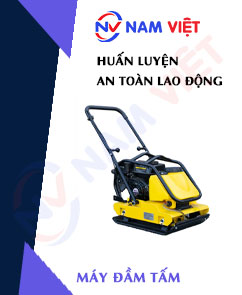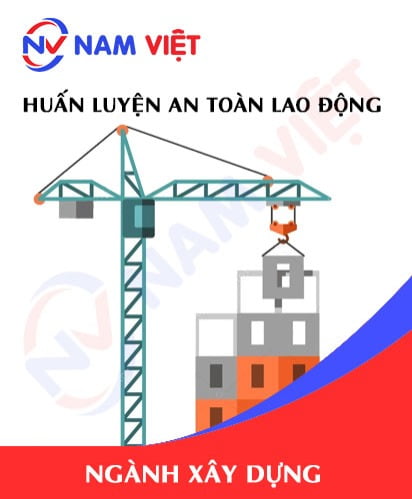Occupational Safety Training for Operating Plate Compactors
99,000 ₫
Note: The above price is calculated per person and may vary depending on the number of participants in the course and market fluctuations. For more accurate pricing, please refer to the price list or contact our consulting staff directly.
Occupational safety is an important issue when operating a plate compactor and needs to be addressed promptly to ensure the health and safety of workers while enhancing the reputation of enterprises. The Occupational Safety Training course is an effective solution to raise awareness among workers on how to prevent workplace accidents when operating a plate compactor.
Table of Contents
Toggle1. Overview of Plate Compactor Machine
a. What is a Plate Compactor Machine?
A plate compactor machine is an industrial device used to compress soil, sand, gravel, concrete, and other construction materials to create a hard, flat, and solid surface. Plate compactors are commonly used in infrastructure construction, civil works, building projects, and various other applications.
The device includes a movable or fixed base plate attached to a combustion or electric engine, generating high pressure to compact materials beneath the plate. When operating, the plate moves rapidly up and down, creating a vibrating impact. The pressure and vibration force the material particles to settle closely together, strengthening the surface and minimizing the risk of collapse or settlement.
Plate compactor machines come in various sizes and power ratings to suit specific tasks, ranging from small machines for minor jobs to large machines used in major construction projects.

b. Operating Principle of a Plate Compactor Machine
The plate compactor machine works by using pressure and vibration to compact materials such as soil, sand, gravel, or concrete. Here’s how it operates:
- Compaction Plate: The machine has a flat steel or cast iron plate at the bottom, which serves as the main contact surface with the material to be compacted.
- Engine: Equipped with a gasoline, diesel, or electric engine, the machine generates the necessary force and provides energy for operation.
- Vibration: A vibration mechanism, either integrated into the engine or separate, moves the plate rapidly up and down, creating the compacting effect.
- Contact and Compaction: As the plate moves, it applies strong pressure to the material surface, forcing particles to settle together, achieving compression and surface consolidation.
- Forward Movement: The operator guides and moves the machine over the surface to ensure even compaction across the area.

c. Industries Using Plate Compactor Machines
Plate compactor machines are widely used across various industries, including:
- Construction: Main users of plate compactors, for compacting soil, sand, gravel, and concrete before building foundations, roads, sports fields, etc., ensuring a hard and flat working surface.
- Infrastructure Construction: Used for compacting soil and sand in projects such as drainage, dams, bridges, and irrigation works.
- Landfill Management: Employed to compact and stabilize waste layers, reducing collapse risk and creating a firm surface for waste handling.
- Railway and Highway Construction: Ensures a stable base for tracks and roads, enhancing safety and durability.
- Ports and Airports: Compacts sand and soil to create hard surfaces for runways and circulation areas.
- Mining and Manufacturing: Used to compact soil, rocks, and gravel in preparation for mining or transport processes.
- Public Infrastructure Projects: Utilized in parks, golf courses, sports fields, and other construction projects for surface consolidation and compaction.
2. Overview of Occupational Safety Training for Plate Compactor Operation
a. What is Occupational Safety Training?
- Occupational safety training for operating plate compactor machines consists of sessions aimed at raising awareness about accident prevention for workers. Workers directly operating plate compactors fall under Group 3.
- The training helps workers identify and avoid hazards, reducing the risk of workplace accidents.
REGISTER FOR OCCUPATIONAL SAFETY TRAINING SERVICE
b. Training Duration
Initial Safety Training:
- Total training hours is at least 24 hours, including examination time.
- 8 hours of theory on safety policies and labor hygiene laws
- 8 hours of basic safety and hygiene theory
- 4 hours of specialized theory training
- 2 hours of practical specialized training
- 2 hours of final theoretical examination
Training centers usually split the schedule into multiple sessions depending on workers’ availability, typically 6 sessions over 3 days if continuous training is possible.
Periodic Safety Training:
- Before the occupational safety card expires, workers must complete periodic safety training to renew it, with periodic training duration being at least 50% of the initial training duration.
Explanation: Total periodic safety training lasts at least 12 hours, including exams. Upon successful completion, workers are issued a renewed occupational safety card.
c. Training Content
| No. | TRAINING CONTENT | TRAINING HOURS | |||
| Total | Including | ||||
| Theory | Practice | Exam | |||
| I | Safety Policies and Labor Hygiene Laws | 8 | 8 | 0 | 0 |
| 1 | Overview of the legal framework for occupational safety and hygiene. | 6 | 6 | ||
| 2 | Standards and technical regulations for occupational safety and hygiene. | 1 | 1 | ||
| 3 | Specific regulations from state management authorities regarding safety and hygiene when constructing, expanding, or renovating facilities, including machinery, equipment, materials, and substances with strict safety requirements. | 1 | 1 | ||
| II | Basic Safety and Hygiene Knowledge | 8 | 8 | 0 | 0 |
| 1 | Basic knowledge of hazards and harmful factors in the workplace. | 4 | 4 | ||
| 2 | Methods to improve working conditions. | 1 | 1 | ||
| 3 | Safety culture in production and business. | 1 | 1 | ||
| 4 | Rights and responsibilities of employers and employees; safety policies; role of safety networks and officers. | 1 | 1 | ||
| 5 | Workplace safety rules, signs, usage of safety equipment and personal protective equipment; first aid and occupational disease prevention skills. | 1 | 1 | ||
| III | Specialized Training Content | 6 | 4 | 2 | 0 |
| Comprehensive knowledge of machines, equipment, hazardous substances; risk analysis, management, and safe working procedures with machinery and substances requiring strict safety standards. | 6 | 4 | 2 | ||
| IV | Final Safety Training Exam | 2 | 2 | 0 | 0 |
| Total | 24 | 22 | 2 | ||
See more training content of 6 groups
d. Occupational Safety Card
After completing the occupational safety training and passing the exam, workers will be issued an Occupational Safety Card (commonly referred to as a Group 3 Safety Certificate).
The Group 3 card displays personal information such as name, date of birth, job, work environment, training duration, red stamp, and signature confirming completion of the training.
According to regulations in Clause 2 of Article 24, Decree 44/2016/ND-CP, there are two cases:
- If the employer and employee have an employment contract, the employer must stamp and endorse the safety card for Group 3 employees after they complete the training and pass the exam from a certified training unit.
- If the worker is freelance or seasonal and does not have an employment contract, the training unit must stamp and endorse the safety card after the worker completes the training and passes the exam.

3. Hazards When Operating a Plate Compactor
Operating a plate compactor can involve several hazards, and users must follow safety rules to ensure their safety and that of others nearby. Here are some common hazards when operating a plate compactor:
- Electric shock: Plate compactors are typically equipped with engines powered by electricity or fuels such as gasoline or diesel. Failure to follow electrical safety rules may lead to electric accidents that can cause fire, explosion, or injury.
- Accidents while driving: When moving the plate compactor over uneven ground, there is a risk of losing control or tipping over, potentially causing injuries to the operator or nearby personnel.
- Vibration and noise: Plate compactors generate high levels of vibration and noise. Prolonged exposure to vibration can cause musculoskeletal and joint injuries for operators. Additionally, noise can harm hearing if proper ear protection is not used.
- Impact hazards: Plate compactors have heavy flattening plates, and direct contact with the plate or moving parts can cause injuries if safety rules are not followed.
- Ground and stone penetration: During operation, there is a risk of the machine sinking into the ground or hitting stones, which can cause injuries or damage the machine.
- Engine explosion or fire: Improper maintenance or unsafe fuel use can lead to engine explosion or fire.

4. Measures to Control Occupational Accidents When Operating a Plate Compactor
To control occupational accidents when operating a plate compactor, follow these safety measures:
- Training: Ensure all plate compactor users are trained on safe operation, including starting, stopping, basic handling, and specific safety rules for the machine.
- Inspection and maintenance: Conduct regular inspections and maintenance to ensure the machine operates safely and reliably.
- Hearing and eye protection: Ensure users wear ear and eye protection to safeguard against noise and debris.
- Safe work environment: Operate the compactor on flat surfaces with ample space to avoid collisions and tipping. Remove unnecessary obstacles and materials from the work area.
- Personal protective equipment (PPE): Operators should wear PPE such as safety vests, helmets, gloves, safety shoes, and protective clothing to minimize injury risk.
- Follow operating rules: Adhere to manufacturer instructions and safety regulations, including using the machine at correct speed and pressure, and not exceeding load capacity.
- Turn off the machine when not in use: Always switch off the machine and place it in a safe position when not in use to prevent accidental accidents.
- Work environment check: Before starting, inspect the work area for ground instability, hazards, or dangerous materials.
- Consider environmental factors: In extreme weather or sandy conditions, take additional safety measures, such as using extra protective equipment.
- Do not exceed machine capacity: Use the compactor according to guidelines to prevent damage or accidents.
- Periodic inspection of the plate compactor helps detect early safety issues such as wear, mechanical failure, or breakdowns, reducing occupational accident risks.
5. Benefits of Occupational Safety Training
An Toàn Nam Việt provides businesses with the following benefits after completing occupational safety training courses according to Decree 44/2016/ND-CP on occupational safety and hygiene:
- Employees can identify potential occupational hazards and take preventive measures to avoid accidents.
- Businesses can establish risk prevention measures in production, operation, and maintenance processes.
- Reduce costs associated with workplace safety incidents.
- Continuous production increases labor productivity and product quality.
- Compliance with labor safety laws to avoid legal risks.
- Enhances corporate reputation and professionalism, strengthening the business brand.
Nam Việt training courses are designed to help individuals prevent external hazards that could lead to injuries or, in severe cases, death.
REGISTER FOR OCCUPATIONAL SAFETY TRAINING
6. Customer Feedback After Completing Training
An Toàn Nam Việt has years of experience supporting enterprises across Vietnam, especially in the southern provinces. This responsibility is highly valued, and Nam Việt continually focuses on professional occupational safety training. Positive feedback and suggestions from partners have driven Nam Việt’s growth. Below are testimonials from clients we have served.
See more customer interviews after using our services at An Toàn Nam Việt
7. Occupational Safety Training Capability of An Toàn Nam Việt
An Toàn Nam Việt is a reputable and quality occupational safety training center in Vietnam. Training sessions are conducted continuously at factories, workshops, and construction sites nationwide (all 63 provinces of Vietnam).
REGISTER FOR OCCUPATIONAL SAFETY TRAINING
Occupational Safety Training License
- An Toàn Nam Việt has been inspected and certified by the Department of Safety under the Ministry of Labor – Invalids and Social Affairs to meet the requirements for occupational safety and hygiene training, strengthening our training capabilities.

Training Materials and Lectures
- All materials used in occupational safety training courses are reviewed to ensure accuracy and effectiveness.
- Instructors follow standardized teaching methods developed by An Toàn Nam Việt, based on expert research in occupational safety and hygiene training, to maximize knowledge transfer.
Facilities
- Proper classroom environment control enhances teaching efficiency and student learning.
- Our facilities supporting training provide spacious classrooms meeting standards for area, lighting, and training equipment.
8. Nationwide Reputable Safety Training Center
At An Toàn Nam Việt, we prioritize occupational safety training. We prepare meticulously, from tools and equipment to teaching materials, audio, and lighting.
Our instructors are experts with years of experience and research in hazard identification and prevention. Lectures are practical, engaging, and compliant with Decree 44/2016/ND-CP, enabling workers to understand and apply safety measures effectively.
Our safety training center prides itself on providing professional and reliable services:
- Competitive training costs with guaranteed quality.
- Flexible training schedules tailored to production requirements.
- Quick and legal certification procedures.
- Experienced instructors.
- Classroom environment control for efficient learning.
- Lectures tailored to occupational safety needs of enterprises.
- Dedicated and professional service to support clients efficiently.

9. Additional Occupational Safety Training Materials
- Occupational Safety Training Materials
- Safety Materials for Plate Compactor Operation
- Occupational Safety Training Test Collection
- Plate Compactor Safety Quiz
- Plate Compactor Safety Training Slides
1 review for Occupational Safety Training for Operating Plate Compactors
No comments yet















phanminhhang341
Đơn vị chuyên nghiệp về huấn luyện an toàn lao động